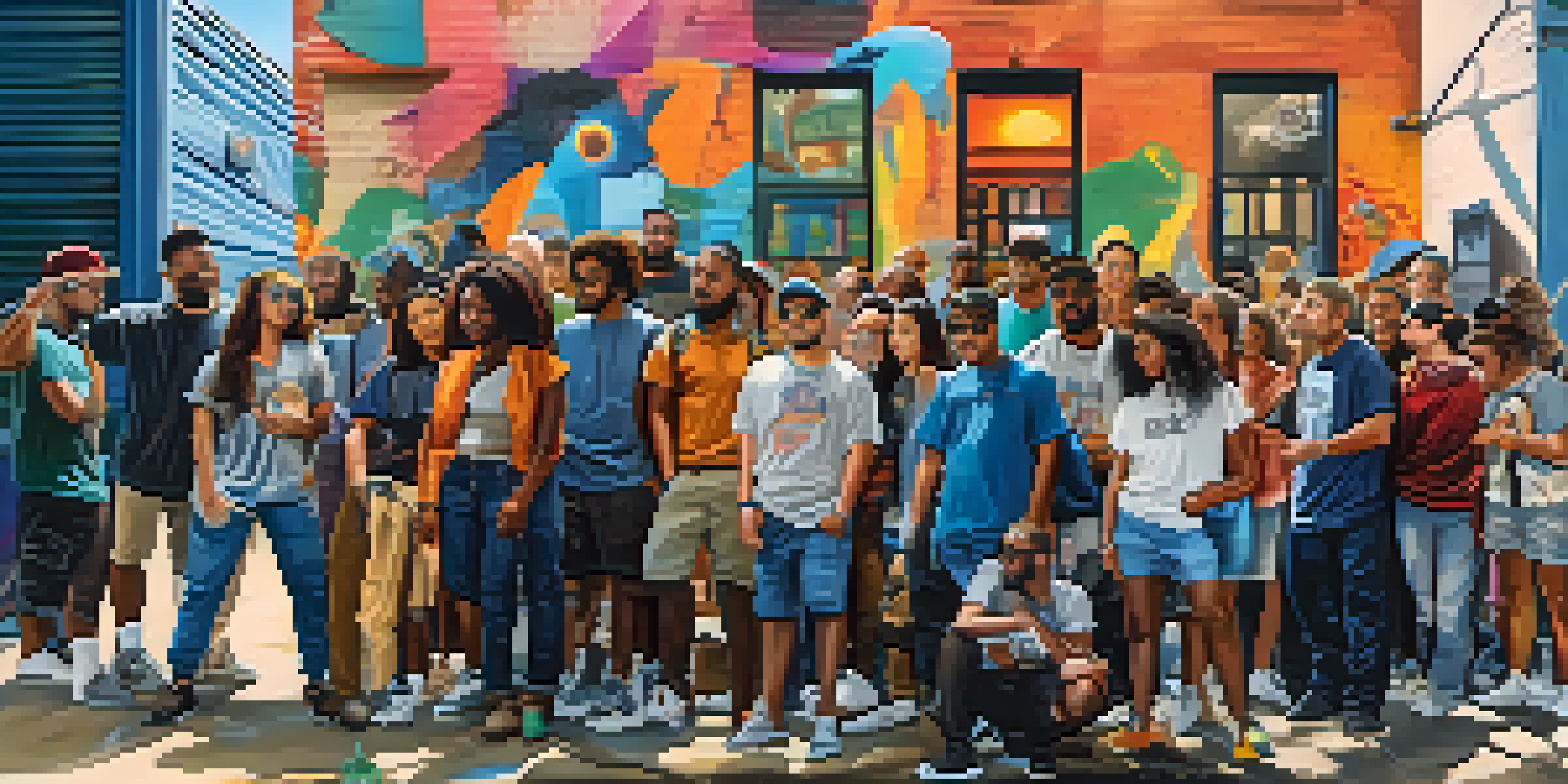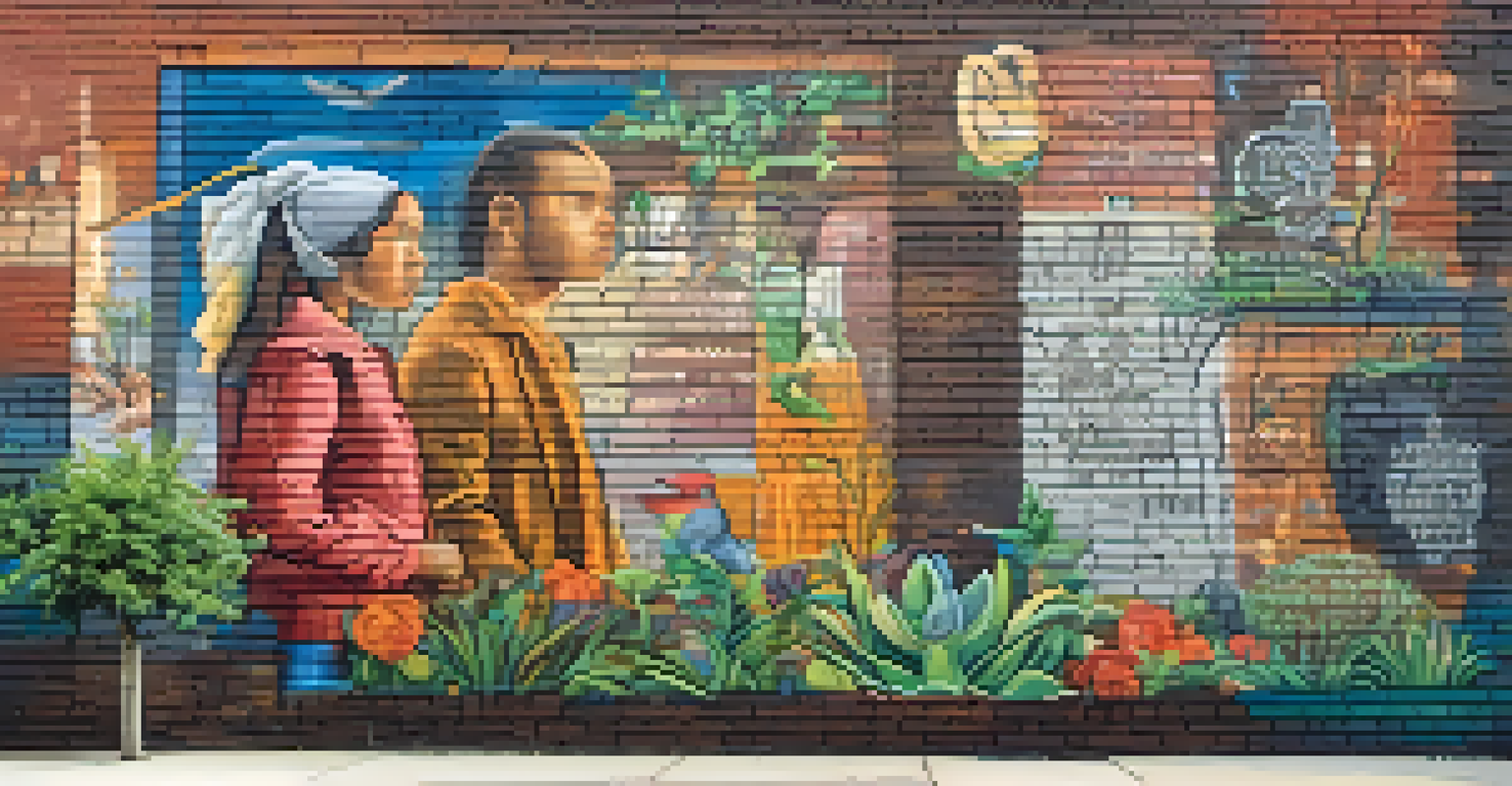Exploring the Evolution of Art Collectives in Urban Areas

The Birth of Art Collectives in Urban Spaces
Art collectives began sprouting in urban areas during the late 20th century, primarily as a response to the commercialization of art. Artists sought to collaborate, share resources, and create a sense of community outside traditional galleries. This shift marked a significant departure from individualistic approaches to art-making, allowing for diverse voices to emerge.
Art is not a mirror held up to reality, but a hammer with which to shape it.
As cities became melting pots of culture, the need for collaborative spaces grew. Artists from various backgrounds found common ground, leading to the establishment of collectives that celebrated their unique perspectives. These early collectives laid the groundwork for what would evolve into a thriving artistic movement within urban environments.
By creating alternative spaces, these collectives not only supported local artists but also engaged the community in the artistic process. This grassroots approach helped to democratize art, making it accessible to a broader audience and fostering a sense of belonging within the urban landscape.
The Role of Technology in Modern Art Collectives
With the rise of the internet, art collectives have found new ways to connect and collaborate. Social media platforms and online galleries have provided artists with a global stage, allowing them to share their work far beyond their local communities. This technological evolution has transformed the dynamics of artistic collaboration.

Artists can now collaborate in real-time, regardless of geographical boundaries. Virtual exhibitions and online workshops have become commonplace, enabling collectives to thrive in the digital age. This shift has not only expanded their reach but also introduced innovative ways to engage audiences.
Art Collectives Foster Community
Urban art collectives emerged as collaborative spaces that promote diversity and inclusivity, enriching the cultural landscape.
However, the reliance on technology also presents challenges. As the art world becomes more virtual, the essence of physical community spaces can be diluted. Striking a balance between digital and physical interactions remains crucial for the longevity of these collectives.
The Impact of Gentrification on Urban Art Collectives
Gentrification has played a pivotal role in shaping the landscape of urban art collectives. As neighborhoods undergo revitalization, rising rents can displace long-standing artistic communities. This transformation often leads to a tension between the original artists and new residents, complicating the dynamic of local art scenes.
The role of the artist is to make the revolution irresistible.
Many collectives have emerged as advocates for their communities, pushing back against the forces of gentrification. Through public art projects and community engagement, they strive to preserve their cultural heritage while adapting to changing environments. This activism highlights the importance of art as a tool for social change.
Despite the challenges, gentrification can also create opportunities for exposure and collaboration. New businesses and residents may bring fresh ideas and resources, leading to innovative partnerships that benefit both artists and the community. Navigating this complex relationship remains a key focus for urban art collectives.
Diversity and Inclusion in Urban Art Collectives
One of the most significant advancements in urban art collectives is the emphasis on diversity and inclusion. Historically, the art world has been criticized for its lack of representation, but many collectives actively work to change this narrative. By fostering diverse membership, these groups create a richer tapestry of artistic expression.
Collectives now prioritize inclusivity, welcoming artists from varying backgrounds, ethnicities, and gender identities. This shift not only enhances creativity but also challenges the status quo, encouraging dialogues around social justice and representation within the arts. The impact can be seen in the works produced, which often reflect a broader spectrum of experiences.
Technology Transforms Art Collaboration
The rise of digital platforms has enabled artists to connect globally, transforming how art collectives collaborate and engage with audiences.
As these collectives champion diversity, they also inspire future generations of artists. Young creatives see themselves represented and are motivated to join or form collectives, perpetuating this cycle of inclusivity. This ongoing evolution is essential for the health and vitality of the art community.
Art Collectives as Agents of Social Change
Urban art collectives have increasingly positioned themselves as agents of social change. Through their work, they address pressing societal issues, such as inequality, climate change, and community displacement. By leveraging their artistic platforms, these groups aim to provoke thought and inspire action among their audiences.
Many collectives engage in activism through public art initiatives, organizing events that bring attention to social causes. Murals, installations, and performances often serve as powerful statements, encouraging communities to reflect on their values and take a stand. This blending of art and activism has proven to be a potent force for change.
Moreover, these collectives often collaborate with local organizations, amplifying their impact. By partnering with nonprofits and community groups, they further their mission and extend their reach. This symbiotic relationship not only strengthens the collective but also enhances the community's resilience.
The Future of Urban Art Collectives
As we look to the future, urban art collectives are poised to continue evolving. With the ongoing influence of technology and shifting societal norms, these groups will adapt to meet the needs of their communities. Their ability to innovate and collaborate will be vital in navigating the challenges ahead.
Emerging trends, such as eco-friendly art practices and digital storytelling, are likely to shape the direction of collectives. As artists increasingly prioritize sustainability, we may see a rise in projects that focus on environmental consciousness. This shift could redefine what it means to be an urban artist in the coming years.
Collectives Address Social Issues
Urban art collectives serve as agents of social change, using their artistic expression to tackle pressing societal issues and advocate for their communities.
Ultimately, the resilience and adaptability of urban art collectives will be crucial. By staying connected to their communities and embracing change, these collectives can continue to inspire, engage, and uplift, ensuring that art remains a dynamic force within urban areas.
Conclusion: The Enduring Legacy of Art Collectives
The evolution of urban art collectives reflects broader cultural shifts and the enduring power of community. These collectives have not only transformed the artistic landscape but also fostered a sense of belonging and purpose within urban areas. Their journey is a testament to the importance of collaboration in the creative process.
As we celebrate the achievements of these collectives, it’s essential to recognize their role in advocating for change and inclusivity. They have opened doors for underrepresented voices and championed social causes, leaving a lasting impact on both the art world and society at large.

Looking ahead, the legacy of urban art collectives will undoubtedly continue to inspire future generations. Their commitment to creativity, community, and social justice ensures that the spirit of collaboration will thrive, making the urban landscape a vibrant canvas for all.